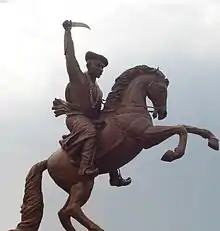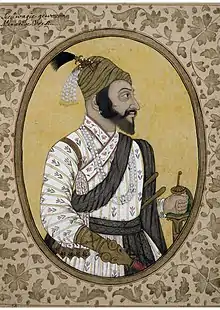Prataprao Gujar
Prataprao Gujar was senapati of Shivaji army.[1][2][3] He was a highly gifted aristocratic general, who enjoyed the trust of his king and the loyalty of his troops. He defeated a large Mughal Army at the famous Battle of Salher. Salher was a major battle between the Mughals and the Marathas, and the first large-scale pitched battle between the two in open field. The victory of the Marathas at Salher is seen as a definitive turning point in their military prowess against the mighty force of the Mughals. Prataprao Gujar's major drawback was his impulsive emotional nature.
Pratap Gujar | |
|---|---|
 Statue of Prataprao Gurjar | |
| Born | 1615 |
| Died | 24 February 1674 |
A few months before Shivaji's coronation in 1674, Prataprao Gujar was sent to deal with the invading force led by the Adilshahi General Bahalol Khan. The Maratha Army surrounded the camp of Bahalol Khan at the place of Nesari. Prataprao's forces defeated and captured the opposing general in the battle. In spite of specific warnings against doing so by Shivaji, Prataprao released Bahalol Khan along troops and the seized war material, when Bahalol Khan promised not to invade Maratha territories again. Days after his release, Bahalol Khan started preparing for a fresh invasion.
When Shivaji heard of Prataprao's decision, he was incensed and wrote an angry letter to Prataprao refusing him permission to see him till such time, until Bahlol Khan was re-captured. Prataprao realised his mistake and was so upset about what he had done that he now wanted to capture Bahlol Khan at any cost.
On 24 February 1674, he learnt that Mughal general Bahlol Khan was camping nearby. Prataprao decided to make a stand against Balol Khan at Nesari. Prataprao Gujar with 1200 troops were against Khan with 15000. So, Prataprao reasoned that there was no point in taking 1200 men to suicide with him. So, in a fit of anger and overreacting to the letter, he left alone, without asking his cavalry to charge. It was his personal honour at stake, not his army. On seeing their leader head to certain death, 6 other Maratha sardars joined him in the charge, they attacked the enemy camp, and were slaughtered by the Mughal Army. Anandrao and Hansaji Mohite stayed back. It was an impulsive decision and the loss of Prataprao Gujar was a big loss to the Marathas. Anandrao Mohite managed to take the Maratha Army to safer areas.
Maratha Army avenged the death of their general, by defeating Bahlol Khan and looting his jagir (fiefdom) under the leadership of Anandrao and Hambirrao Mohite. Hambirrao Mohite became the new Sarnaubat (Commander-in-chief of the Maratha forces).
Shivaji was deeply grieved and saddened on hearing of Prataprao Gujar's death at the hands of the Mughals. [4]
References
- Shrivastavya, Vidayanand Swami (1952). Are Rajput-Maratha Marriages Morganatic?. D.K. Shrivastavya, 1952. p. 15,136.
- Bahadur), Mahadev Govind Ranade (Rao (1900). Rise of the Maratha Power. Punalekar & Company.
- Tod, James (1884). Annals and Antiquities of Rajastʼhan: Or the Central and Western Rajpoot States of India. S.K. Lahiri.
- Ranade, Mahadeo Govind (2006). Rise of the Marathapower. Read Books. p. 35. ISBN 978-1-4067-3642-7. Retrieved 22 September 2008.
